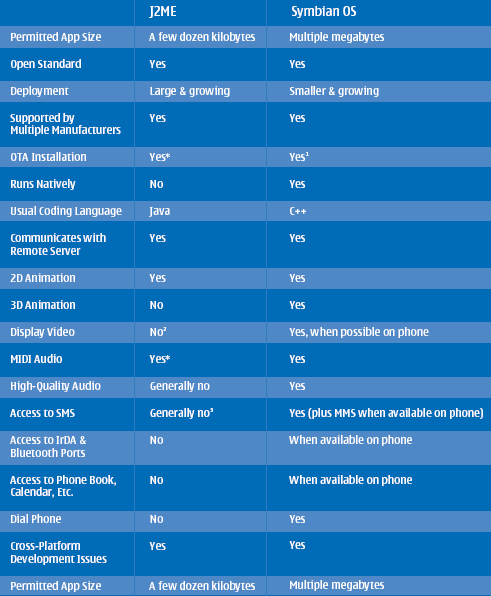Which Platform?
In the first stage of research I have investigated the different options available for developing applications on mobile devices. Although other systems are available I chose to focus on the two leading platforms of J2ME and SYMBIAN. A brief description of these systems is as follows.
J2ME
An interpreted language such as Java, which for mobile phones means J2ME (Java 2 Micro Edition). Javaenabled
handsets are in wide and increasing deployment, and virtually all phone manufacturers (including
Nokia) have committed to production of J2ME-enabled mobile phones. Although other interpreted
languages are available on some handsets, J2ME is an open standard, easily learnable by programmers
with Java experience, and more widely supported by handset manufacturers than the others.
Symbian OS
An operating system for powerful smartphones that runs applications written in the C++ language and
compiled to machine code. Smartphones are less widely deployed than Java-enabled phones, but more
fully featured and capable of running more sophisticated applications, and will experience further market
penetration over time. As with J2ME, there are competing “smartphone” operating systems in
deployment, but phone manufacturers representing more than 70% of the market (including Nokia,
Sony-Ericsson, Siemens, and Panasonic) have committed to the use of Symbian OS for their
smartphones, making it more widely supported than other operating systems. Additionally, Symbian OS
is an open standard, available for license by any hardware manufacturer, and is specifically designed for
use with wireless communication devices, thus providing superior functionality.
The following chart provides a high-level comparison of the capabilities of the two technologies:

* Except for some older legacy phones.
1 However, Symbian OS applications are typically so large that OTA installation is impractical.
2 J2ME can display video in phones that support the Java Mobile Media API (such as the Nokia 3650).
3 Access to SMS from J2ME is possible using the Nokia SMS API (supported on the Nokia 3410s) or Wireless Messaging
API (WMA, supported on the Nokia 3650 and newer Nokia 3410s).
Chosen Platform: Symbian OS
After examining the development environments for each system and looking through existing software I decided that the SYMBIAN platform would be more appropriate for the project. Some of the following factors lead to this decision.
1. Previous experience in C++.
2. Improved sound support and 12bit graphics.
3. Ability to produce 'cutting edge' audiovisuals on a mobile device.
4. Support for Nokia series 60 phones (some Sony/Ericcson, Siemens)
5. Symbian is a next generation mobile OS with increasing support (N-gage e.t.c.)
More information on Symbian can be found at www.symbian.com and more details on nokias Symbian support at www.forum.nokia.com see also references.
Conclusion
Although further research would be beneficial it is obvious from the initial findings that the Symbian platform offers a familiar programming system and (for a mobile device) a powerful graphics engine. The issue with control would be a problem when writing for any mobile device (except one specifically designed to play games GBA for example) but a simple and elegant solution should be defined (with a minimal set of keys). In terms of sound the application may have to deal with unstable timing but there is a possibility to use MIDI instruments in order to reduce filesize (only supported on the 3650). All these concerns will be taken into account when defining a technical & design document for the chosen project idea.
Reference Points
There are a number of artistic and commercial projects that act as inspiration to the Plug-In project. The intention is to learn from these existing products/methods to make the project a synthesis of new ideas and good practice. A small selection is detailed below.
Toshio Iwai:

Toshio Iwai has created many beautiful yet simple audiovisual games where the users can play in an open ended environment to create constantly changing patterns of sound and light. His work has been exhibited world-wide and used as performance tools by prominent composers.
Ixi Software / Golan Levin / SoundToys / Processing

These four sites provide free tools and documentation on small scale computer audiovisual composition toys and tools. The individual projects range from complex synthesis to simple atmospheric music.
Mr Driller / Chu Chu Rocket / Puzzle Bobble

These three games have little to do with audio, but they base their addictive and innovative gameplay on very simple rules that create emergent behaviour and wide variation (much in the vein of tetris). They also work in a scalable manner performing well on both handheld devices,consoles and PC.
Spheres of Chaos / rRootage / Turux.org

These two games and the website Turux.org use simple but effective algorithmic graphics techniques to generate abstract generative images. Often derived from the 'demo scene' such techniques are designed to work within the strict program parameters defined by most mobile/handheld devices.
Next: Project Stage 1 >>>






